NFL Game Speed Training: Unlocking Elite Athletic Performance
When it comes to the NFL, speed, agility, and strength are paramount to success on the field. Every NFL player needs to be explosive, capable of changing direction rapidly, and able to power through resistance. One of the best ways to train for these qualities is through a specialized training program designed to improve game speed. This article explores a high-level training session, breaking down the key drills and exercises that help players develop the agility, power, and reaction time needed to excel at the highest levels of football.
1. Change of Direction Plyometrics: The Foundation of Speed Training
The session kicks off with a focus on change of direction, which is essential for every football player. Whether it’s a quarterback dodging a sack, a wide receiver making a sharp cut to get open, or a defensive back reading a receiver’s movements, the ability to change direction quickly and with control is vital.
In this phase of the training session, athletes perform crossover runs. These drills require players to keep their hips low and their eyes focused backward while accelerating through the motion. Keeping the hips low ensures that the athlete maintains a strong and stable base, improving balance and making it easier to pivot or cut sharply. The quick acceleration helps build speed, while maintaining control in these dynamic movements helps improve overall agility.
The crossover run not only enhances agility but also builds muscular endurance and explosiveness in the lower body. The fast, controlled movements train the muscles to react faster, a key component in NFL game speed.
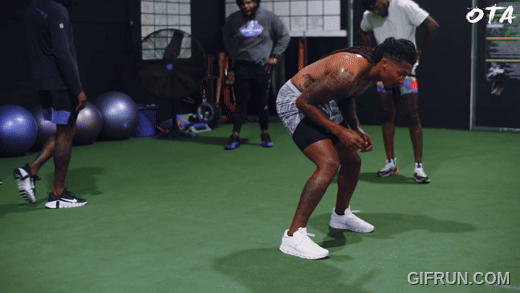
2. Skater Jumps: Stabilization and Core Tightness
Next, the session introduces skater jumps, a plyometric exercise designed to enhance stabilization, core tightness, and smooth transitions between jumps. The skater jump is simple yet highly effective. Athletes begin in a squat position, and then push off one leg laterally, landing on the opposite leg in a controlled manner. This lateral movement mimics the side-to-side shuffles players often perform on the field when changing direction.
This drill works on both balance and core stability. Maintaining a tight core during the landing is crucial, as it helps the body remain stable and prevents the athlete from losing control or momentum. Additionally, the transition from one jump to the next must be smooth and swift, mimicking the rapid changes in direction that are common in a game situation.
By incorporating skater jumps into the training, players improve their lateral agility, which is key when covering ground on the field quickly or reacting to an opponent’s movements.
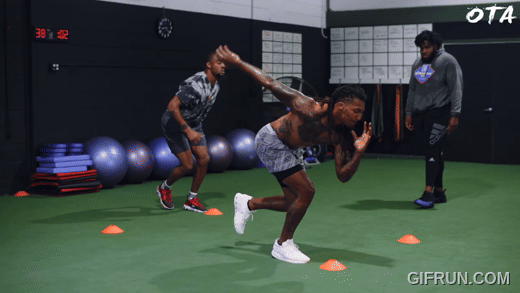
3. Reactive Drills: Building Quickness and Agility
One of the most crucial skills for any football player is the ability to react quickly to sudden changes. In this session, reactive drills are introduced to enhance a player’s reaction time and agility. These drills involve players performing a jump, then quickly returning to a flat position before moving in a lateral or horizontal direction.
The goal of this exercise is to improve the athlete’s ability to quickly recover and reorient themselves after a dynamic movement. For example, when a player makes a jump or change of direction on the field, they need to be able to return to their base position quickly and maintain their balance to continue their movement.
The reactive drill, by requiring athletes to jump and then immediately reorient themselves, mirrors situations that occur during games, where a player might need to quickly adjust to a new position, whether it’s to track an opponent, recover from a missed tackle, or reposition themselves for a better offensive play.
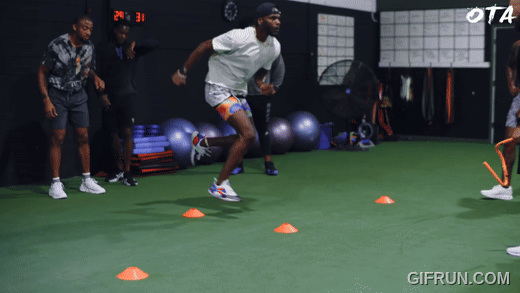
4. Single-Leg Movements and Hurdle Jumps: Enhancing Explosive Speed
As the session progresses, the intensity and complexity of the drills increase. At this stage, players perform single-leg movements and hurdle jumps, which further enhance explosive power and speed. These drills are designed to work on the explosive strength of the legs, which is essential for quick starts, sharp cuts, and high-intensity bursts of speed.
The single-leg hurdle jump is a fantastic way to challenge the athlete’s ability to generate power with one leg while maintaining control and stability. The drill requires players to jump over hurdles using a single leg at a time, alternating legs with each jump. This exercise increases unilateral strength, which is important for making explosive plays during the game when an athlete must rely on one leg to change direction or accelerate.
Lateral pushes are incorporated into the hurdle jumps, ensuring that players develop the necessary skills for sidestepping an opponent, pivoting, or making a sharp cut. The addition of bursts of explosive speed in between the hurdles further enhances the athlete’s ability to accelerate rapidly after each change of direction.
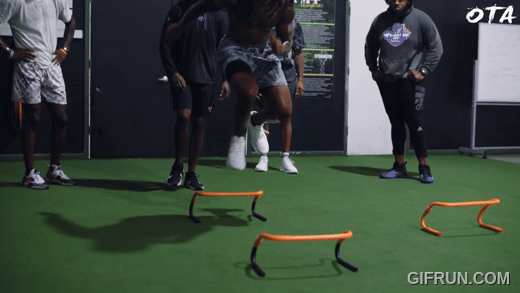
5. Agility and Resistance: Sled Work and Integration
Finally, the session concludes with a comprehensive focus on agility and lower body resistance training. These elements tie together all the previous drills, pushing players to integrate speed, strength, and coordination into a complete training regimen.
Agility drills are essential for players who need to move quickly and decisively, whether they are running routes, evading tackles, or closing in on a ball carrier. By incorporating short, quick movements, such as cone drills or 90-degree cuts, players can sharpen their ability to change direction rapidly and with precision.
The final component of the session involves sled work, which builds lower body strength and helps with explosive power. The sled works by providing resistance during sprints, making it harder for athletes to move but forcing their muscles to work harder, thereby increasing strength and stamina. This resistance training is vital for improving both straight-line speed and the ability to maintain speed under physical stress, which is often required in a football game.
Through sled training, athletes can also improve their acceleration and maximal speed, two crucial factors in achieving NFL-level game speed.
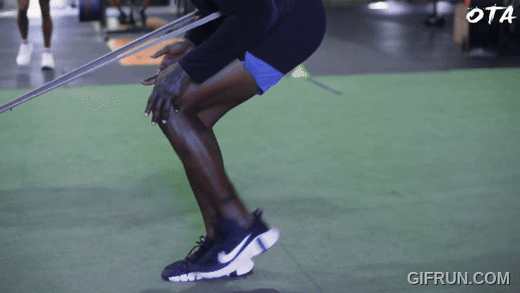
Conclusion: The Path to NFL Game Speed
The training session described here takes athletes through a series of progressively challenging drills, each designed to enhance different aspects of football performance. Starting with change of direction and building to advanced explosiveness and resistance work, players are equipped to become faster, more agile, and stronger.
From plyometric drills like the crossover run and skater jumps, to reactive drills and single-leg movements, the training emphasizes not just raw speed but also balance, core stability, and reaction time. Finally, the integration of agility drills and sled work pushes players to develop both strength and speed simultaneously, preparing them for the physical demands of the NFL.
By consistently incorporating these drills into their training routine, athletes can unlock their full potential and perform at the highest level on game day. Whether you’re an aspiring professional or a seasoned player, mastering these techniques will put you on the fast track to becoming a more explosive and agile football player.
Interested in learning more? If you’re looking for a complete football training system to further enhance your skills, check out the full resources linked below. Keep training, stay sharp, and get ready to elevate your game to the next level!
